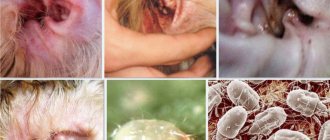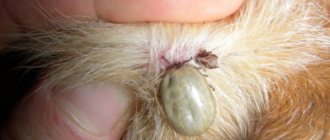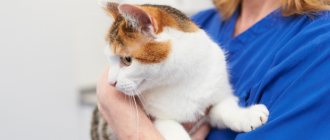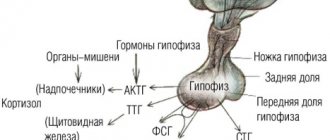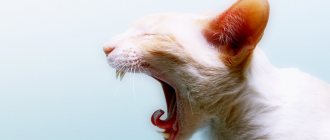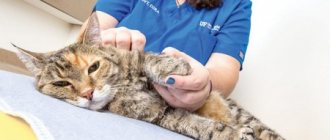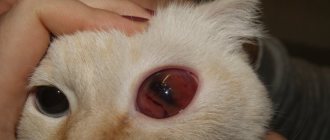- home
- Treatment
- Cat diseases
- Perforated eardrum in cats
The eardrum is a thin partition located between the outer and middle ear. It serves to transmit sound vibrations to the inner ear and prevent infection and foreign objects from entering.
If the integrity of the eardrum is damaged, bacteria and fungi from the external auditory canal penetrate deeper and can cause internal and otitis media. Inflammation of the inner and middle ear is a serious disease and requires immediate treatment.
Symptoms of otitis media
Frequent accompaniments of otitis media are pain, itching, redness of the skin on the inner surface of the ear, and increased discharge from the ears. A cat can often scratch its ear, until bald patches and wounds appear on the auricle, and does not allow the ear to be touched. If a cat shakes its head, this indicates discomfort in the ear canal area.
“Dirty” ears, that is, increased secretion of exudate, is also most often a symptom of otitis media. Normally, in cats, discharge from the ears practically does not accumulate, the auricle is clean. If you often need to clean your cat’s ears, you should consult a dermatologist to determine the cause of such an increased amount of exudate.
ethnoscience
If you do not have the opportunity to urgently take MURLYKA to the clinic, then it is worth reducing and muffling the symptoms for a while. There are the following home recipes:
1. Colloidal silver - place 5 drops in each ear or apply to affected areas.
2. Apple cider vinegar - dilute with water in a 1:1 ratio and drop 10 drops into each ear or wipe the reddened areas.
3. Calendula tincture - mix a pharmaceutical solution with 100 ml of warm water and a pinch of sea salt, use the resulting liquid to wipe the ears.
Parasitic otitis
The most common cause of the development of both parasitic otitis media and otitis media in general in cats are mites of the genus Otodectes. The disease they cause is called otodectosis. Signs of this disease include increased dark brown, dry discharge from the ears, as well as itching. Often, bacterial otitis caused by secondary microflora (bacteria and/or fungi) develops against the background of otodectosis. Otodectosis is contagious and can be transmitted from cat to cat or from cat to dog and vice versa. This disease does not pose any danger to people.
Bacterial otitis
Bacterial or microbial otitis is almost always secondary, due to allergies or injuries to the ear cavity. One of the fairly common causes of ear injury in cats is improper cleaning using cotton swabs. Cats have a completely different structure of the auricle; when using cotton swabs, the ear canal is not cleaned due to its anatomical features. The ear canal is curved, so when you try to clean the ear with a cotton swab, all the secretions are compacted, their outflow is disrupted, and this provokes the so-called congestive otitis media. Active cleaning with a cotton swab often causes injuries; cotton fibers remain in the ear, which can also cause inflammation.
Ceruminous otitis media develops against the background of irritation of the skin of the external auditory canal. It is characterized by increased release of sulfur. Frequent ear cleaning, especially using cotton swabs, also contributes to its development. The more the wall of the external auditory canal is irritated, the more the glands work.
Necrosis of the auricle
Tissue death is the most unfavorable scenario in the absence of proper treatment or due to incorrect diagnosis. At the sites of inflammation, ulcers form, through which the ear cartilage begins to appear directly. Poor circulation leads to necrosis of cartilaginous tissues - they turn black and emit a putrid odor. During the process of decay, the ear becomes deformed, which is visible to the naked eye.
In addition to lost time in the treatment of injuries and hematomas, the following factors may be the reasons for the development of necrosis:
- Infection of the auricle due to the entry of pathogenic microflora into abscesses and lymphatic extravasation;
- “transition” of purulent processes from nearby tissues;
- Prolonged compression of the ear in an unnatural position.
It is impossible to cure necrosis using inoperable methods. Only complete or partial amputation of the auricle is performed.
Immune-related otitis
Otitis can occur against the background of various types of allergies. Most often, as a result of an allergy to flea saliva, this is also how atopic allergies (to environmental factors, such as dust) or food allergies manifest themselves.
There is such a disease as proliferative and necrotizing otitis media in kittens. It develops only in kittens and is manifested by erosions and ulcers on the skin of the ear canal and the appearance of areas of necrotic tissue. As a rule, with this disease there is no pain syndrome and the kittens’ ears do not bother them at all. The disease is not contagious. It is easily treated with immunosuppressants, as it is immune-mediated.
Also, otitis in cats develops against the background of an autoimmune disease such as pemphigus foliaceus. In this case, not only the ears are most often affected, but also the scalp and other areas.
Hematomas
Hematomas appear as a result of an impact due to the accumulation of dried blood under the skin of the animal, which appears after the rupture of blood vessels.
Swelling and swelling, darkening of the skin requires mandatory examination and further treatment; surgical intervention is often prescribed, which involves opening the hematoma.
Otitis caused by the presence of a neoplasm or foreign body
Otitis develops when foreign bodies enter the ear. Often the cause is the same cotton swabs, which break off or cotton flakes separate and get into the ear canal. Also, the cause may be grass seeds - this is typical for cats walking in the country.
It is not uncommon for cats to develop neoplasms of the ceruminous glands (glands that secrete sulfur). Such tumors are called cerumin. If the tumor opens and becomes infected, then purulent, and sometimes purulent discharge mixed with blood, can be observed from the ears. In such cases, it is necessary to perform otoscopy to visualize the tumor.
.
DIAGNOSIS OF OTITIS
There are many causes of otitis, and treatment will vary significantly, so it is necessary to determine what exactly caused the inflammation. This can only be done by a dermatologist; it is impossible to do this at home - you need a laboratory.
The primary diagnosis of otitis media includes:
- inspection,
- otoscopy,
- taking a cytological smear from the external auditory canal,
- scraping and trichoscopy in case of demodicosis (rare).
Additional methods are used to diagnose neoplasms or otitis media:
- video otoscopy under anesthesia,
- radiography,
- MRI/CT examination.
In some cases, it is necessary to take a bacterial culture from the ear to determine sensitive flora.
Otitis media in cats can develop as a primary disease, unlike dogs, in which otitis media most often develops against the background of external otitis media when the eardrum is perforated; in cats, the integrity of the eardrum does not exclude otitis media.
The causes of otitis media in cats include: viruses, mycoplasmas, bacterial infections from the respiratory tract, nasopharyngeal polyps. Additional diagnostics are required to determine the causes.
Symptoms of otitis media include:
- pain,
- tilting the head towards the affected ear,
- neurological symptoms, as the ocular and facial nerves may be affected.
Video of an ear examination of a cat with otitis media.
Signs
The most common signs of vestibular system disease are:
- ataxia (lack of coordination and balance);
- head tilt;
- movement in a circle;
- falling to one side of the body;
- nausea (motion sickness);
- strabismus (deviation of the eyeballs) and nystagmus (anterior and posterior, superior and inferior, or rotational movement of the eyes).
The cat will fall, spin, or tilt its head towards the side of the body where the main disturbance is located.
Diseases of the vestibular apparatus are divided into peripheral (if the disease lies in the inner ear) and central (if the brain stem is affected). In addition, signs of the disease may be unilateral or bilateral. Cats with bilateral peripheral problems exhibit mild feelings of disorientation; but the muscles of their limbs function normally.
Deficits in postural responses such as placement and proprioception of the limbs may be present, along with mental decline (depression or decreased consciousness). Rarely, a form of central vestibular disease affects the side of the body opposite the affected side. The development of neurological deficits in a cat's head may involve loss of sensation or movement of the face.
Treatment of otitis media in cats
Treatment comes down to eliminating the etiological factor (antiparasitic drugs, removal of polyp/tumor, immunosuppressants for autoimmune diseases), as well as eliminating secondary microflora and hygiene of the external auditory canal. However, a treatment method that can eliminate the cause of otitis media can be chosen only after consultation with a doctor, who will determine this cause. It is highly not recommended to use any drops at home before visiting a doctor, even as recommended by a veterinary pharmacy - if the integrity of the eardrum is damaged, this will lead to very severe deviations. The doctor will determine the cause of otitis in the cat and select a treatment regimen that can be carried out at home. To sanitize the external auditory canal, you can use warm saline solution or special lotions or chlorhexidine bigluconate 0.05%. Lotions and chlorhexidine can only be used on the recommendation of the attending physician, since if the eardrum is perforated, they also cannot be used. Different lotions have different effects (antiseptic, sulfur dissolution, drying effect, etc.).
The article has already repeatedly mentioned how you can’t clean a cat’s ears—you can’t use cotton swabs or just cotton wool. To properly sanitize the ear canal, you need to completely fill the ear with the solution, massage the base of the auricle, then let the cat shake its head. Remove any remaining dirt from the surface of the ear with a bandage, but not with cotton wool or cotton swabs, since the microvilli of cotton wool further irritate the skin of the inflamed ear canal. You need to treat your ears several times until the dirt stops coming out. This procedure must be repeated 1-2 times a week, in especially severe cases 3-4 times.
Ear diseases and home treatment methods
Hepatopathy in cats: liver diseases, symptoms and treatment
Some problems can be dealt with at home by first consulting a veterinarian.
Ear fungus
If the infection is localized to the skin, medicated shampoos are prescribed to soothe the skin and eliminate odors. Antifungal medications are also prescribed to reduce the amount of fungus and bacteria. Medicinal ointment with insecticides is effective.
The fungus affects not only the inner, but also the outer part of the ear
In severe cases, the doctor will prescribe steroid injections, depending on the cat's condition.
Necrosis of the auricle
The lesions are characterized by thick crusts and plaques that can collapse or form again. Secondary bacterial and fungal infections aggravate the condition. In some cases, it goes away spontaneously, but only after 12–24 months. Therapy with topical tacrolimus or oral cyclosporine at a dose of 5 mg/kg/day is effective.
Dermatitis and eczema
In some cats, the inner, hairless part of the ear becomes inflamed and irritated after using certain ointments or medications. This inflammation, called contact dermatitis, can develop 1 to 7 days after the reaction begins. The skin of the abalone becomes red and swollen, and crusts or ulcers appear.
Cool baths, medicated shampoos and conditioners, and calming sprays can help your pet. Mild allergies are treated with antihistamines or omega-3 fatty acids.
Hematomas and abscesses
You need to carefully cut off as much hair as possible from the painful area in order to better see the size of the wound. Then clean and apply hydrogen peroxide to the wound to disinfect.
Important! Do not use alcohol or antibiotic ointments for an abscess. The alcohol burns, but she will lick the ointment.
Scabies mite (otodectosis)
With this disease, the cat's ears become wet. Signs of ear mites include excessive skin scratching, head shaking, a strong odor, and dark discharge. Before using the medicine, you need to rinse and clear the black waxy deposits and dirt from the ear canal. Drug treatment usually uses topical drops containing a pyrethrin insecticide.
Ticks not only cause discomfort, but also carry infections.
Apple cider vinegar is allowed to be used as a natural remedy. You need to mix it with warm water and treat the wounds for several days.
Inflammation of the middle and inner ear
Sometimes the middle and inner parts of the ear become infected. This occurs either because the outer ear infection has moved deeper into the ear or because the bacteria has spread through the bloodstream or eustachian tube. If a cat has wet ears inside, this is the first symptom.
Important! For first aid, homemade antiseptics are used: furatsilin, peroxide, boric acid.
Yeast fungus (Malassezia) in the ears
Malassezia is part of the normal flora of the skin, ears, and mouth. Has a symbiotic relationship with staphylococcus. Topical therapy usually focuses on the use of shampoo, however there is a newer product (Douxo Chlorhexidine PS with alpazole).
The systemic drug of choice for cats is itraconazole 3–5 mg/kg orally once daily for 15–30 days. Typically, dramatic improvement occurs within 7-10 days.
Tumors and neoplasms
Not every growth on a cat's ear will be cancerous, but should be checked by a veterinarian. Older cats and those with white ears and heads are especially susceptible to skin cancer. A biopsy is required to confirm the diagnosis.
Foreign object in the ear
If you see a large piece of grass or something else in your ear that shouldn't be there, you should try to carefully pull it out with your fingers or tweezers. If resistance is felt or the cat appears uncomfortable, stop immediately and call your veterinarian. The doctor will calm the cat, safely remove the foreign body, examine it for damage, and prescribe medications for healing.
Regular inspection and cleaning will help avoid many troubles.
Concha hematoma in cats
The main manifestation of a hematoma is swelling of the outer area of the ear. The condition usually occurs in only one ear. The animal will show pain, shake its head, and may tilt its head to one side.
A clear sign of hematoma is asymmetry and swelling
Surgery is the most common treatment for hematoma. The cat is placed under anesthesia and a small incision is made on the bottom of the ear. The fluid drains out and stitches are placed in the affected area. They are removed after 2-3 weeks.
Ulcers
A sore in a cat’s ear requires determining the cause of its occurrence. Pain relievers, anti-inflammatory medications, antibiotics, and antifungal medications are just a few treatment options your veterinarian may recommend for a cat with skin ulceration.
Advice! To provide first aid, you can anoint the rim of the sore with Levomekol.
Sulfur plugs
For treatment, disinfectants are used, for example, 3% boric acid solution, hydrogen peroxide, chlorhexidine solution. It is convenient to treat ears with special care devices (manufacturer names: Bars, Otoklin, Rosinka, Leo Cat Cleaner, Otifree and Hartz). Specialized products help to more effectively dissolve deposits and sulfur impurities, do not irritate the pet’s delicate skin and are hypoallergenic substances.
Otitis
Chronic otitis media is a long-term infection. Therapy begins with cleansing and the use of medications such as antimicrobials and anti-inflammatory drugs. Corticosteroids are sometimes used to reduce pain, redness, and swelling.
Attention! Diagnosis of the underlying disease is necessary. Ear diseases in cats can be treated with medication, although sometimes surgery may be the only option.


